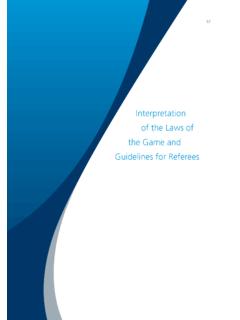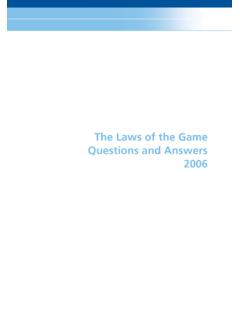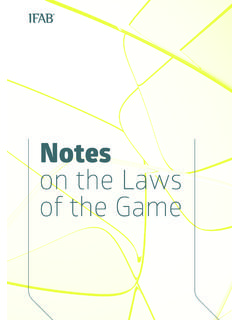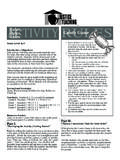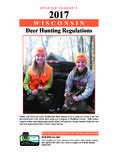Transcription of ADVICE TO REFEREES ON THE LAWS OF THE GAME
1 UNITED STATES SOCCER FEDERATION ADVICE TO REFEREES ON THE laws OF THE GAME UNITED STATES SOCCER FEDERATION ADVICE TO REFEREES ON THE laws OF THE GAME Acknowledgments The United States Soccer Federation s National referee Development Program is very pleased to acknowledge the work of the instructors who contributed to this third, updated edition of the ADVICE to REFEREES on the laws of the Game. The principal authors of the original publication were Jim Allen, who doubled as editor, and Dan Heldman. Substantial contributions to this updated edition came from Gil Weber, Ulrich Strom and Wally Beaumont (contributor and proofreader extraordinaire).
2 Many of the additions and changes came about as the result of questions or suggestions from REFEREES , players and coaches across the country. Alfred Kleinaitis Manager of referee Development and Education 2005 ADVICE to REFEREES on the laws of the Game Revised 2005 United States Soccer Federation, Inc. 1801 S. Prairie Avenue Chicago, Illinois 60616 Telephone: 312/808-1300 Fax: 312/808-1301 Table of Contents Acknowledgments Table of Contents ADVICE to REFEREES Law 1 The Field of Play Law 2 The Ball Law 3 The Number of Players Law 4 The Players Equipment Law 5 The referee Law 6 The Assistant referee Law 7 The Duration of the Match Law 8 The Start and Restart of Play Law 9 The Ball In and Out of Play Law 10 The Method of Scoring Law 11 Offside Law 12 Fouls and Misconduct Part A.
3 Fouls Part B. Misconduct Part C. Serious Foul Play and Violent Conduct Part D. Denying an Obvious Goalscoring Opportunity Law 13 Free Kicks Law 14 The Penalty Kick Law 15 The Throw-In Law 16 The Goal Kick Law 17 The Corner Kick Law 18 Common Sense Section 19 Miscellaneous Matters Index [This page purposely left blank] ADVICE to REFEREES In early 1997, the International Football Association Board (IFAB) issued a general rewrite of the laws of the Game which took effect worldwide on July 1, 1997. This new text was the first complete revision of the laws since the modern version was first issued about sixty years ago.
4 In 2000, the IFAB issued a major revision of the Questions and Answers to the laws of the Game, which provided firm guidance on many principles behind the laws of the Game. Over that period, the seventeen laws of the Game were augmented by IFAB decisions, interpretations, guidelines, instructions, and items of ADVICE from both the IFAB and the Federation Internationale de Football Association (FIFA). Further, the United States Soccer Federation (USSF) has issued additional instructions and guidance to clarify the IFAB's decisions and indicate how they were to be applied in the USA. New ADVICE in this edition reflects changes in the laws of the Game for 2004-2005 and in the Questions and Answers on the laws of the Game (2004).
5 These changes and others will be shown through a vertical bar at the righthand edge of the page. This book of ADVICE to REFEREES is specifically intended to give USSF REFEREES , assistant REFEREES and fourth officials a reliable compilation of those international and national guidelines remaining in force, as modified or updated. It is not a replacement for the laws of the Game, nor is it a "how to" book on refereeing. It is one of a number of sources of information: the laws of the Game, published annually by USSF from the text provided by the IFAB through FIFA; the Questions and Answers to the laws of the Game, distributed for the IFAB by FIFA; annual FIFA Circulars, as republished in designated USSF annual Memoranda; the USSF Guide to Procedures for REFEREES and Assistant REFEREES and the Guide for Fourth Officials; entry-level referee clinics, in-service clinics and referee recertification clinics taught by USSF instructors.
6 Other official publications from the USSF instructional program, including articles in Fair Play and specific subject memoranda. While every effort will be made to keep this ADVICE up to date through new editions, changes in the Law may result in an item becoming inaccurate or outdated. When this occurs, USSF will specify the relevant section of the ADVICE and will state clearly the necessary changes, so that REFEREES can mark their copy appropriately until a new edition can be published. ADVICE to REFEREES presents official USSF interpretations of the laws of the Game. Affiliated leagues, associations, competitions, and officials must implement them to the fullest extent possible.
7 Participants in affiliated matches must not impose personal, unsupported, or unofficial interpretations of any provisions of the laws of the Game. If a point is not made in this ADVICE , look first to the relevant Law or laws of the Game for the answer. Entries or portions of entries are italicized if they discuss matters which are less well known or less commonly understood. [This page purposely left blank] Law 1 The Field of Play DIMENSIONS The length of the field must always exceed the width. The dimensions of the field of play may vary to enable players of different levels of skill and physical attributes to play the game. The size of the field of play and the width between the goal posts and height of the crossbar from the ground may be modified for matches between players of under 16 years of age, for women, for players over 35, and for players with disabilities, provided USSF approves the modifications.
8 SAFETY REFEREES should arrive in plenty of time to inspect the field, goals, flags and markings for accuracy and safety. No part of the field surface or the goals and flagposts may be dangerous to the players. If the field conditions are dangerous or unsuitable for play, the referee must refuse to officiate the game and, unless there is a possibility that the problem can be corrected, should leave immediately after announcing his decision to both sides. Unresolved problems with the field that do not involve safety should be reported to the competition authority, even if the game is played. GOALS The goals must be securely anchored to the ground.
9 For safety reasons, if the goals are not securely anchored to the ground, the match shall not be played. FLAGPOSTS The compulsory corner flagposts and the optional halfway flagposts should be no less than 5 feet high; anything shorter is dangerous to the players. If used, the optional halfway flagposts must be at least 1m/1 yard outside the touch line. FIELD MARKINGS The markings of the field should not be dangerous, must not protrude above the surface or be placed in ruts or hollows, and should be easily visible. The goal line should be the same width as the depth of the goal posts and the crossbar. The lines belong to the areas of which they are the boundaries.
10 The area beyond the goal line and crossbar and inside the goal net (if one is provided) is not part of the field of play. The optional line drawn outside the field of play, 10 yards from the corner arc and at right angles to the goal line, may not touch the goal line. The line allows the officials to judge that defenders keep the proper distance at the taking of the corner kick. If a photographer's line is provided, it must be marked behind the goal lines in accordance with the rules of the competition. If the lines are not marked properly, the referee should try to have proper markings put down by the home team before starting the game, time permitting.

